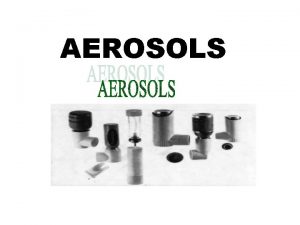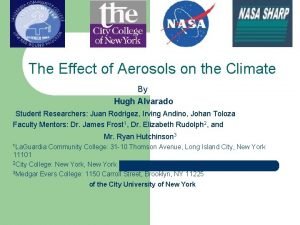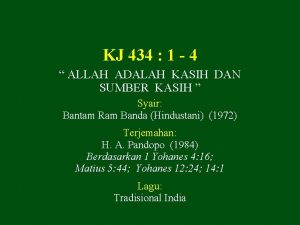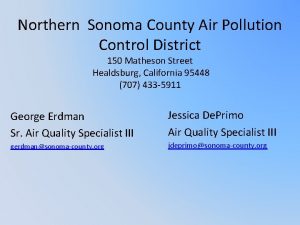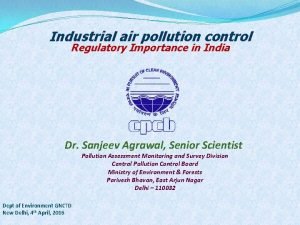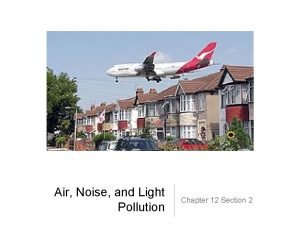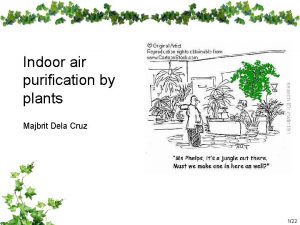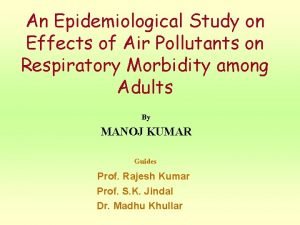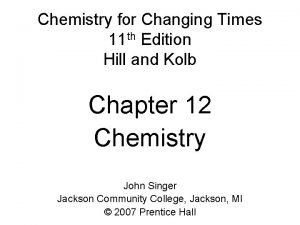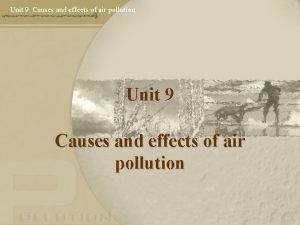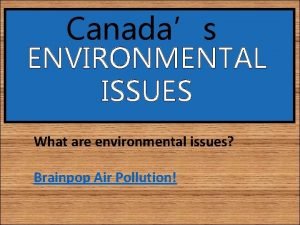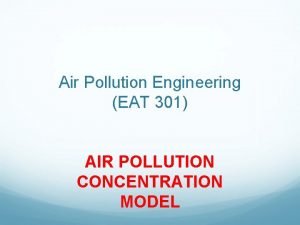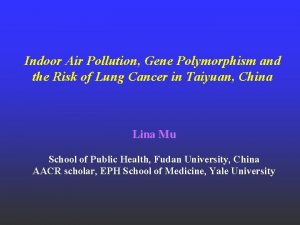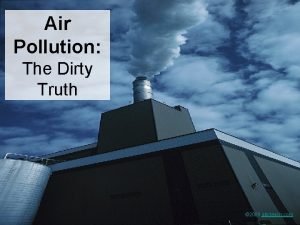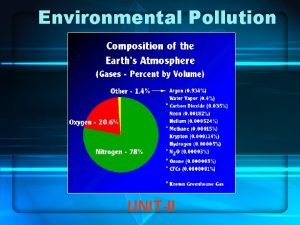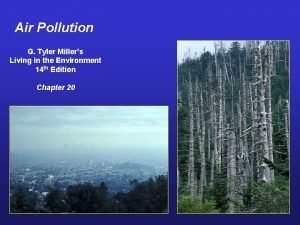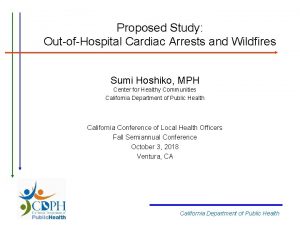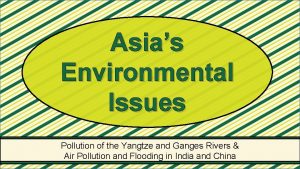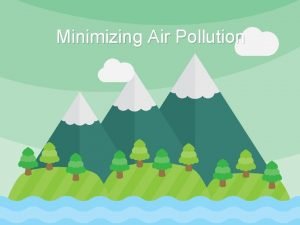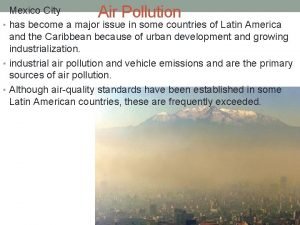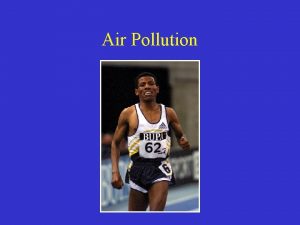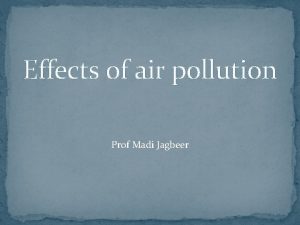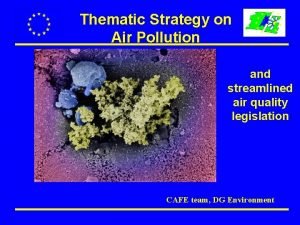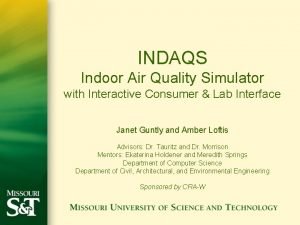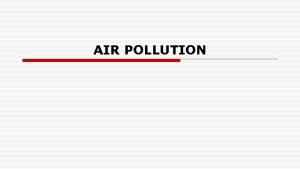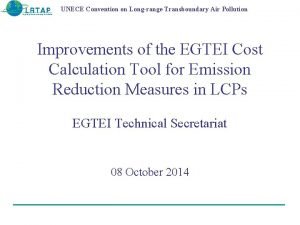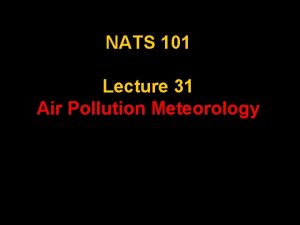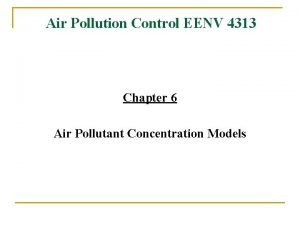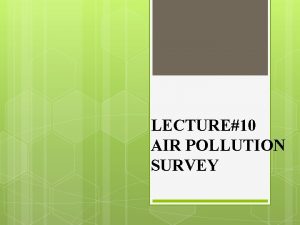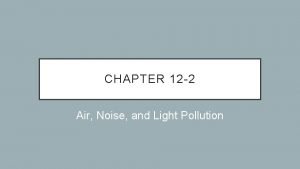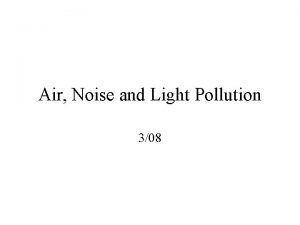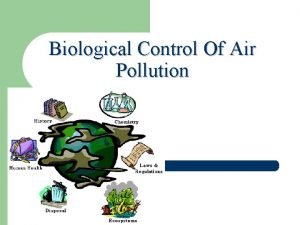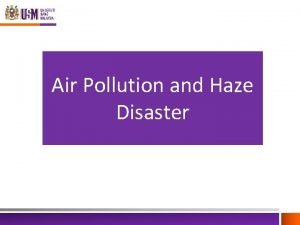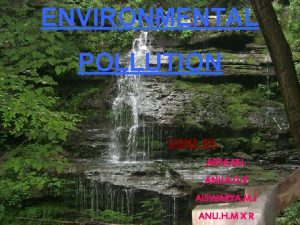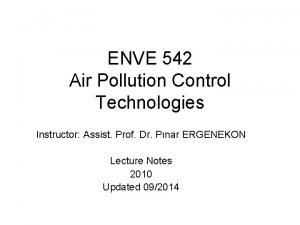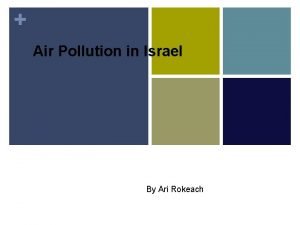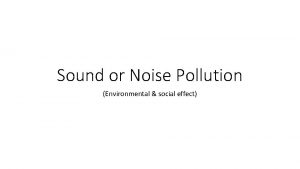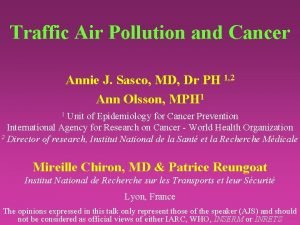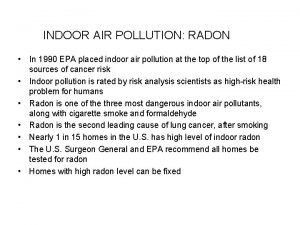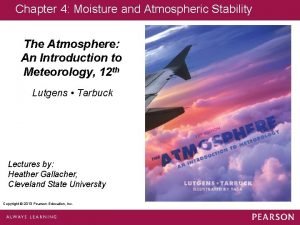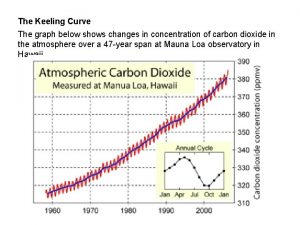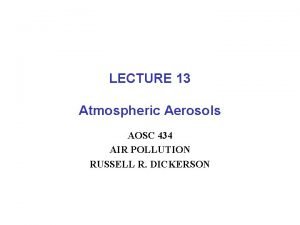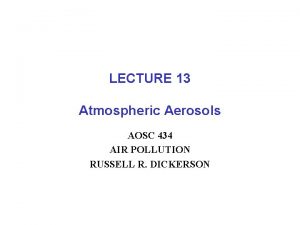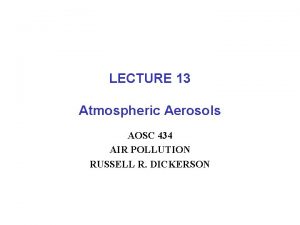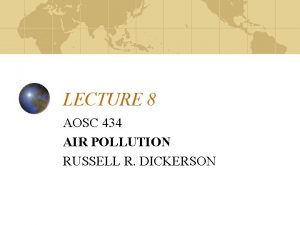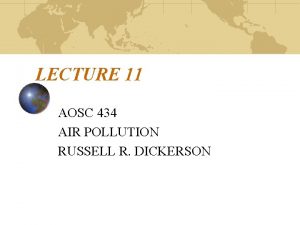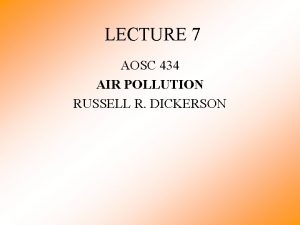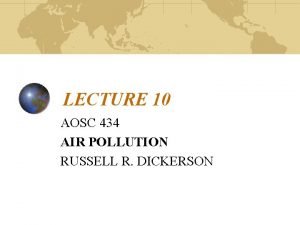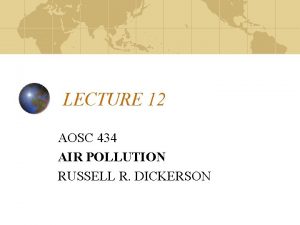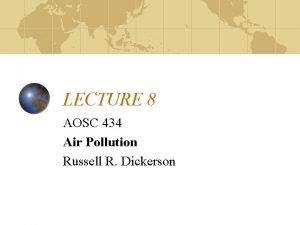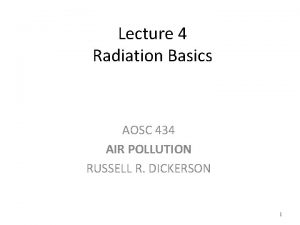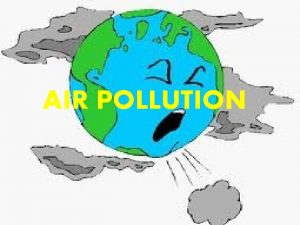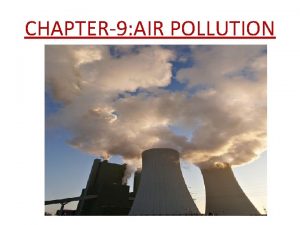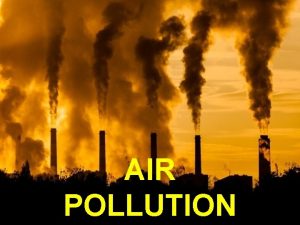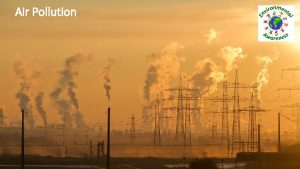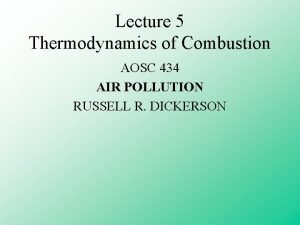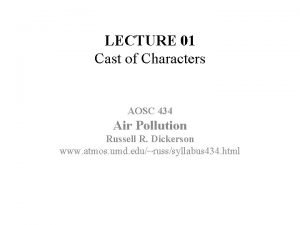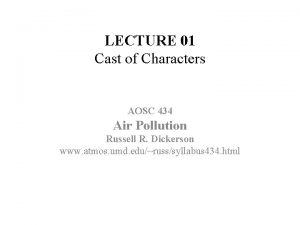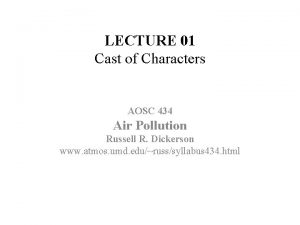LECTURE 13 Atmospheric Aerosols AOSC 434 AIR POLLUTION













![TYPICAL U. S. AEROSOL SIZE DISTRIBUTIONS Fresh urban Aged urban rural remote Warneck [1999] TYPICAL U. S. AEROSOL SIZE DISTRIBUTIONS Fresh urban Aged urban rural remote Warneck [1999]](https://slidetodoc.com/presentation_image_h2/d43190a15f2679e12271a163f1a47349/image-14.jpg)

















![BLACK CARBON EMISSIONS DIESEL DOMESTIC COAL BURNING BIOMASS BURNING Chin et al. [2000] BLACK CARBON EMISSIONS DIESEL DOMESTIC COAL BURNING BIOMASS BURNING Chin et al. [2000]](https://slidetodoc.com/presentation_image_h2/d43190a15f2679e12271a163f1a47349/image-32.jpg)









































- Slides: 73

LECTURE 13 Atmospheric Aerosols AOSC 434 AIR POLLUTION RUSSELL R. DICKERSON

Atmospheric Aerosols Bibliography Seinfeld & Pandis, Atmospheric Chemistry and Physics, Chapt. 7 -13 Finlayson-Pitts & Pitts, Chemistry of the Upper and Lower Atmosphere, Chapt. 9. Classic papers: Prospero et al. Rev. Geophys. Space Phys. , 1607, 1983; Charlson et al. Nature 1987; Charlson et al. , Science, 1992. Recent Papers: Ramanathan et al. , Science, 2001; Andreae and Crutzen, Science, 1997; Dickerson et al. , Science 1997; Bond et al. , JGR, 2013; Landrigan et al. , The Lancet, 2017.

EPA REGIONAL HAZE RULE: FEDERAL CLASS I AREAS TO RETURN TO “NATURAL” VISIBILITY LEVELS BY 2064 …will require essentially total elimination of anthropogenic aerosols! • clean day moderately polluted day Acadia National Park http: //www. hazecam. net/

INTRODUCTION: Particles are one of the most important and certainly the most visible aspects of air pollution. The effects span the areas of health (1% increase in mortality per 10 μg m-3); acid rain, visibility degradation, radiation and photochemistry and cloud microphysics changes (and thus climate changes), and the Antarctic ozone hole. For a view into the "bad old days" see Killer Smog by William Wise. NOMENCLATURE: Particle refers to a solid or liquid, larger than a molecule, diameter > 0. 01 μm, but small enough to remain in the atmosphere for a reasonable time, diameter < 100 μm. Particulate is an adjective, in spite of what EPA tries to say. Aerosol is a suspension of particles in a gas.

Particles, like gases, are characterized by chemical content, usually expressed in mg m-3, but unlike gases, particles also have a characteristic size. We may want to start discussion the characteristics of atmospheric aerosols by addressing the question "What is the mean diameter of the particles? " The answer to this question changes with your point of view. A. Size Number Distribution If your concern is the mass of some pollutant that is being transported through the air for biogeochemical cycles, then you want to know the mean diameter of the particles with the mass or volume. In other words, "What size particles carry the most mass? ” If your concern loss of visibility then you want to know the diameter of the particles that have the largest cross section or surface area. In other words, "What size particles cover the largest surface area? " If your concern is cloud formation or microphysics then you want to know the range of diameters with the largest number of particles. In other words, "What is the size of the most abundant particles? " If your concern is human health then you need to know about both the mass and number of the particles, because only a certain size particle can enter the lungs.

Here we define the number distribution function, fn (Dp), and the number of particles with diameter between Dp and Dp + d. Dp in a cm 3 of air as follows: fn(Dp) d. Dp (particles cm-3/mm) The total number of particles, N, is given by the following integral (everywhere we integrate from 0 to infinite diameters): N= f (D ) d. D n p p (particles cm-3 )

We can define a surface area distribution function, fs(Dp), for spherical particles as follows: fs(Dp)d. Dp = p. Dp 2 fn(Dp ) (mm 2 mm-1 cm-3 ) This gives the surface area of particles in a size range per cm 3 of air. The total surface area of the particles, S, is given by the integral over all diameters: S = fs(Dp) d. Dp = p Dp 2 fn (Dp) d. Dp (mm 2 cm-3)

Likewise the volume distribution function and the total volume: fv (Dp) d. Dp = {p/6} Dp 3 fn (Dp) V = fv(Dp) d. Dp = (mm 3 mm-1 cm-3 ) p/6 Dp 3 fn(Dp) d. Dp (mm 3 cm-3) The distributions based on log Dp can be defined in a similar manner, where n(log Dp)dlog. Dp is the number of particles in one cm 3 with diameter from Dp to Dp + log Dp. The total number is: N = n(log Dp) d(log. Dp) (particles cm-3 ) The normalized distribution functions based on log Dp for surface area and volume are similar. For the differential number of particles between Dp and Dp + d. Dp we use the notation d. N, and likewise d. S and d. V, we can represent the size distribution functions as n (log Dp) = {d. N} / {N dlog. Dp } ns (log Dp) = {d. S} / {S dlog. Dp } nv (log Dp) = {d. V} / {V dlog. Dp } This is the common notation for expressing the variation in particle number, surface area or volume with the log of the diameter.

B. Chemical Composition The bimodal nature of the size-number distribution of atmospheric particles suggests at least two distinct mechanisms of formation, and the chemical composition of the particles reflects their origins. Fine particles have a diameter smaller than about 2. 5 mm, and are produced by the condensation of vapors, accumulation, and coagulation. They have a chemical composition that reflects the condensable trace gases in the atmosphere: SO 2, NH 3, HNO 3, VOC’s, and H 2 O. The chemical composition is water with SO 4 -2, NO 3 -, NH 4+, Pb, Cl-, Br-, C(soot), and organic matter; where biomass burning is prevalent, K+. Coarse Particles have a diameter greater than about 2. 5 mm, are produced by mechanical weathering of surface materials. Their lifetimes, controlled by fallout and washout, are generally short. The composition of particles in this size range reflects that of the earth's surface - silicate (Si. O 2), iron and aluminum oxides, Ca. CO 3 and Mg. CO 3; over the oceans , Na. Cl.

ORIGIN OF THE ATMOSPHERIC AEROSOL Aerosol: dispersed condensed matter suspended in a gas Size range: 0. 001 m (molecular cluster) to 100 m (small raindrop) Soil dust Sea salt Environmental importance: health (respiration), visibility, radiative balance, cloud formation, heterogeneous reactions, delivery of nutrients…

AEROSOL NUCLEATION # molecules 1 2 3 4 DG Surface tension effect Thermo driving force Critical cluster size

Atmospheric Aerosols Copyright © 2010 R. R. Dickerson 12

Aerosol Distributions Number • cloud formation Surface • visibility Volume • mass Mass & Number • human health
![TYPICAL U S AEROSOL SIZE DISTRIBUTIONS Fresh urban Aged urban rural remote Warneck 1999 TYPICAL U. S. AEROSOL SIZE DISTRIBUTIONS Fresh urban Aged urban rural remote Warneck [1999]](https://slidetodoc.com/presentation_image_h2/d43190a15f2679e12271a163f1a47349/image-14.jpg)
TYPICAL U. S. AEROSOL SIZE DISTRIBUTIONS Fresh urban Aged urban rural remote Warneck [1999]

SAMPLE AEROSOL SIZE DISTRIBUTION (MARINE AIR) Sea salt Sulfate (natural)

From USEPA (Neil Frank)

Global satellite-derived map of PM 2. 5 averaged over 2001 -2006. Credit: Dalhousie University, Aaron van Donkelaar https: //www. nasa. gov/topics/earth/features/health-sapping. html

U. S. satellite-derived map of PM 2. 5 averaged over 2001 -2006. Credit: Dalhousie University, Aaron van Donkelaar

C. Optical Properties and Visibility The optics of aerosol science follow the most rigorous physics. Traditionally defined visibility is the distance at which a large dark object, such as a hill or a barn can just be seen. A more quantitative definition can be obtained by considering the change in intensity of light reflecting off an object as a function of the scattering of light by the atmosphere. DI/I = e(-b. DX) Where I is the intensity of light, b (or bext) is the extinction coefficient with units of m-1, and X is the distance in m. The limit to visibility for the human eye is a 2% change in intensity relative to the background or: DI/I = 0. 02

Atmospheric Visibility (absorption & scattering) 1. Residual 2. Scattered away 3. Scattered into 4. Airlight

Radiation and fine particles

The extinction coefficient represents the sum of the extinctions from gases and particles, each of which can in turn be divided into extinction due to absorption or scattering. bext = bgas + bparticles bext = babs + bscatt babs (gases) = Beer's Law absorption bscatt (gases) = Rayleigh Scattering babs (particles) = Usually < 10% of extinction bscatt (particles) = Mie Scattering = (bsp) The ultimate limit to visibility in a very clean atmosphere is Rayleigh scattering, but Mie scattering usually dominates. The range of bsp is 10 -5 m -1 to 10 -3 m-1. Single scattering albedo, w, is a measure of the fraction of aerosol extinction caused by scattering: w = bsp/(bsp + bap)

Optical Properties of Small Particles m = n + ik m = complex index of refraction n = scattering (real part) k = absorption (imaginary part) The real part of the index of refraction is only a weak function of wavelength, while the imaginary part, ik, depends strongly on wavelength.

Refractive indices of aerosol particles at = 589 nm Substance m = n + ik n k Water 1. 333 10 -8 Ice 1. 309 10 -8 Na. Cl 1. 544 0 H 2 SO 4 1. 426 0 NH 4 HSO 4 1. 473 0 (NH 4)2 SO 4 1. 521 0 Si. O 2 1. 55 0 Black Carbon (soot) 1. 96 0. 66 Mineral dust ~1. 53 ~0. 006

The scattering cross section is the product of the mass loading, and the surface area per unit mass; note the ln of 0. 02 is about -3. 9, thus: Visibility ≈ 3. 9(bsp)-1 bsp = S m Where bsp is the scattering coefficient in units of m-1 m is the mass loading in units of g m-3 S is the surface area per unit mass in units of m 2 g-1 For sulfate particles, S is about 3. 2 m 2 g-1 where the humidity is less than about 70%; for other materials it can be greater. Visibility = 3. 9/(3. 2 m) = 1. 2 /(m)

Example: Visibility improvement during the 2003 North American Blackout Normal conditions over Eastern US during an air pollution episode: bsp ≈ 120 Mm-1 = 1. 2 x 10 -4 m-1 at 550 nm bap = 0. 8 x 10 -5 m-1 bext = 1. 28 x 10 -4 m-1 Visual Range ≈ 3. 9/bext = 30 km During blackout bsp = 40 Mm-1 = 4. 0 x 10 -5 m-1 bap = 1. 2 x 10 -5 m-1 bext = 0. 52 x 10 -4 m-1 Visual Range = 3. 9/bext = 75 km

Example: Visibility improvement during the 2003 North American Blackout Single scattering albedo, w, normal = 1. 20/1. 28 = 0. 94 Blackout = 0. 4/0. 52 = 0. 77 With the sulfate from power plants missing, and the soot from diesel engines remaining the visual range is up, but the single scattering albedo is down. Ozone production inhibited. See: Marufu et al. , Geophys Res. Lett. , 2004.

Extinction Coefficient as a PM 2. 5 Surrogate PM 2. 5 = 7. 6 g/m 3 PM 2. 5 = 21. 7 g/m 3 PM 2. 5 = 65. 3 g/m 3 Glacier National Park images are adapted from Malm, An Introduction to Visibility (1999) http: //webcam. srs. fed. us/intropdf. htm

ANNUAL MEAN PARTICULATE MATTER (PM) CONCENTRATIONS AT U. S. SITES, 1995 -2000 NARSTO PM Assessment, 2003 PM 10 (particles >< 10 m diameter) PM 2. 5 (particles >< 2. 5 m) Red circles indicate violations of national air quality standard: 50 g m-3 for PM 10 15 g m-3 for PM 2. 5

AEROSOL OPTICAL DEPTH (GLOBAL MODEL) Annual mean

AEROSOL OBSERVATIONS FROM SPACE Biomass fire haze in central America (4/30/03) Fire locations in red Modis. gsfc. nasa. gov
![BLACK CARBON EMISSIONS DIESEL DOMESTIC COAL BURNING BIOMASS BURNING Chin et al 2000 BLACK CARBON EMISSIONS DIESEL DOMESTIC COAL BURNING BIOMASS BURNING Chin et al. [2000]](https://slidetodoc.com/presentation_image_h2/d43190a15f2679e12271a163f1a47349/image-32.jpg)
BLACK CARBON EMISSIONS DIESEL DOMESTIC COAL BURNING BIOMASS BURNING Chin et al. [2000]




ASIAN DUST INFLUENCE IN UNITED STATES Dust observations from U. S. IMPROVE network April 16, 2001 Asian dust in western U. S. 0 2 April 22, 2001 Asian dust in southeastern U. S. 4 g m-3 6 8 Glen Canyon, AZ Clear day April 16, 2001: Asian dust!

TRANSPACIFIC TRANSPORT OF ASIAN DUST PLUMES GEOS-CHEM Longitude cross-section at 40 N, 16 April, 2001 Source region (inner Asia) Asian plumes over Pacific Subsidence over western U. S. ALTITUDE (km) 10 5 0 100 E ASIA 150 E 150 W LONGITUDE 100 W UNITED STATES T. D. Fairlie, Harvard


The future is hard to predict.

Emissions predicted in 1992

Emissions predicted in 1992

What really happened? National Emission Trends Courtesy of Dr. Hao He http: //www. epa. gov/ttn/chief/trends/index. html

Major NOx controls Implemented after 2000 43


NASA Aura OMI Shows Air Quality is Improving • OMI nitrogen dioxide data indicate a 30 -40% decrease in the pollutant’s levels from 2005 to 2011. • NO 2 levels have dropped through the implementation of emission control devices on coal-burning power plants and more fuel-efficient cars. • NASA AQAST members are working with state air quality agencies to demonstrate the effectiveness of their efforts to improve air quality and to find novel uses of satellite data for air quality applications.

The bad news: PM 2. 5 only fell modestly. SO 2 PM 2. 5 Why? Sulfate was dominant and has a longer lifetime than SO 2. SOA becoming dominant; it also has a lifetime of ~10 d.

Aerosols in the Atmosphere • • • Abundance and size Aerosol concentration is highly variable in space and time. Concentrations are usually highest near the ground and near sources. A concentration of 105 cm-3 is typical of polluted air near the ground, but values may range from 2 orders of magnitude higher in very polluted regions to several lower in very clean air. Radii range from ~ 10 -7 cm for the for small ions to more than 10 µm (10 -3 cm) for the largest salt and dust particles. Small ions play almost no role in atmospheric condensation because of the very high supersaturations required for condensation. The largest particles, however, are only able to remain airborne for a limited time

Aerosol Size Naming Convention Usually divided into three size groups ( D - diameter) 1. Aitken Nuclei ® 2. Large Nuclei ® 0. 2 µm < D £ 2. 5 µm (also called the accumulation mode) 3. Giant Nuclei ® 2 x 10 -3 µm < D £ 0. 2 µm D > 2. 5 µm

Other Naming Convention • Nucleation mode ® D ≤ 0. 1 µm • Accumulation or coagulation mode ® 0. 1 µm < D ~ 1 µm Thought to be most important in natural cloud formation • Coarse Particle Mode ® D ~ 1 µm

Origins of Atmospheric Aerosols 1. Condensation and sublimation of of vapors and the formation of smokes in natural and man-made combustion. 2. Reactions between trace gases in the atmosphere through the action of heat, radiation, or humidity. 3. The mechanical disruption and dispersal of matter at the earth’s surface, either as sea spray over the oceans, or as mineral dusts over the continents. 4. Coagulation of nuclei which tends to produce larger particles of mixed constitution

Aerosol Makeup • Typical substances formed in large quantities by condensation following combustion include ashes, soot, tar products, oils as well as sulfuric acid and sulfates. These particles are primarily within the range of Aitken nuclei. • Mechanical disintegration, by wind and water, of rocks and soil produces particles with diameters > 0. 2 µm. These fall primarily in the large nuclei range. • According to Jaenicke (Science, 308 p. 73, 2005) about 25% of the number of particles with diameter greater than 0. 2 µm are biogenic. (remains to be verified).

Aerosol Makeup - continued • Chemical reactions between nitrogen, oxygen, water vapor and various trace gases (e. g. , sulfur dioxide, chlorine, ammonia, ozone, and oxides of nitrogen) primarily produce particles in the Aitken and Large range. Examples Formation of ammonium chloride from NH 3 and HCl Oxidation of SO 2 to H 2 SO 4 Reaction of sulfur dioxide, ammonia, and water to produce ammonium sulfate particles. Production of higher oxides of nitrogen through the action of heat, ozone or ultraviolet radiation

Cloud Condensation Nuclei - CCN • • • Comprises a small fraction of the total aerosol population Sea salt is the predominant constituent of CCN with D > 1µm For 0. 1 µm < D < 1 µm, the main component is thought to be sulfate, which may be present as sulfuric acid, ammonium sulfate, or from phytoplankton produced dimethyl sulfide (see Charlson et al. , Nature, 326, 655 -661).

Activity Spectrum Let Nc be the number of particles per unit volume that are activated to become cloud droplets. Data from cloud chamber measurements are often parameterized as Nc = C (S-1)k where C and k are parameters that depend on air mass type. Rogers gives: Maritime air: 30 < C < 300 cm-3; 0. 3 < k < 1 Continental air: 300 < C < 3000 cm-3; 0. 2 < k < 2 Thus, for the same saturation ratio, one would expect to find small numbers of CCN per unit volume in maritime air and large numbers per unit volume in continental air.

How aerosols affect the radiative properties of clouds. By nucleating a larger number of smaller cloud drops, aerosols affect cloud radiative forcing in various ways. D Rosenfeld et al. Science 2014; 343: 379 -380 Published by AAAS

Summary 1. 2. 3. 4. 5. 6. 7. Aerosols are the most visible of air pollution classes. The PM 2. 5 (annual average) standard to protect health is 12 g/m 3. Number, surface and volume (mass) all play a role. Log-normal distributions. Single scattering albedo w = bsp/(bsp + bap) Composition reflects sources and sinks. Trends have been downward over North America.

Aerosol Optics - Basics

Size parameter: x = 2 pr/l Wallace & Hobbs Chapt. 4. Copyright © 2010 R. R. Dickerson 58

Forward or back scattering? a. Gases b. Fine particles c. Coarse particles Copyright © 2010 R. R. Dickerson 59

Scattering efficiency, Kl, peaks when D/l ~ l (x ~ p). When the imaginary index of refraction in m = mr + imi is zero, i. e. , all scattering and no absorption. Copyright © 2010 R. R. Dickerson 60

Ångström exponent (Å, or a) is indication of ensemble aerosol size. The greater the value of Å the smaller the particles; for classic optics Å = 0. bext = l-Å Å ≡ - dln(bext)/dln(l) ≈ - (ln(bext 1/bext 2) /ln(l 1/l 2) Where sg is geo stddev. Copyright © 2010 R. R. Dickerson 61 61

Optical Properties: Angstrom Exponent • This formulation describes the dependency of the extinction or aerosol optical thickness (t) on wavelength: Copyright © 2010 R. R. Dickerson 62 62

Haze over Hebei, China • Beijing Normal University, Beijing, China • Office of Weather Modification, Hebei, China • National Science Foundation, US

Aerosol optical properties Over Xingtai May 8, 2016 after light rain

AOD ~ 2500 X 4 E-5 = 0. 10

Vertical profiles of temperature (T) from radiosonde and aircraft measurements made on 8 May 2016 over the Xingtai supersite. Note nocturnal and inversion and residual layer that may be a subsidence inversion.

All of RF 1 Angstrom Exp 450/500 = 1. 85 550/700 = 1. 62 450/700 =1. 69

m-1 x 107 Mean SSA = 0. 87


Summary of RF 1 aerosol properties after light rain For entire flight these were fairly uniform Angstrom Exponent = 1. 62 to 1. 85 SSA = 0. 87 Backscatter/bsp ratio = 0. 12 Over Xingtai Top of PBL = 2500 m AOD ~0. 1

Extra Slides


 Atmospheric chemistry lecture notes
Atmospheric chemistry lecture notes Atmospheric physics lecture notes
Atmospheric physics lecture notes Pressurized dosage form
Pressurized dosage form What are aerosols
What are aerosols Chapter 12 section 3 acid precipitation
Chapter 12 section 3 acid precipitation Chapter 12 air section 1 what causes air pollution
Chapter 12 air section 1 what causes air pollution Pt tanah air sentosa
Pt tanah air sentosa Ece 434
Ece 434 Anatomy team 434
Anatomy team 434 Ece 434
Ece 434 Aatcc 135 test method
Aatcc 135 test method Ece 434
Ece 434 Anatomy team 434
Anatomy team 434 Ece 434
Ece 434 434 x 2
434 x 2 Allah adalah kasih dan sumber kasih
Allah adalah kasih dan sumber kasih 01:640:244 lecture notes - lecture 15: plat, idah, farad
01:640:244 lecture notes - lecture 15: plat, idah, farad Northern sonoma county air pollution control district
Northern sonoma county air pollution control district Air pollution slogan
Air pollution slogan Section 2 air noise and light pollution
Section 2 air noise and light pollution Indoor air pollution sources
Indoor air pollution sources Aim or objectives of air pollution
Aim or objectives of air pollution Air pollution wildfires
Air pollution wildfires What is pollution how is it caused
What is pollution how is it caused Brainpop air pollution
Brainpop air pollution Sources of smog
Sources of smog Air pollution definition
Air pollution definition Air pollution box model example
Air pollution box model example Erg air pollution control
Erg air pollution control Man made resources examples
Man made resources examples Introduction about air pollution
Introduction about air pollution Air pollution specialist
Air pollution specialist Air pollution
Air pollution Indoor air pollution examples
Indoor air pollution examples Air pollution
Air pollution Main cause of air pollution
Main cause of air pollution Baghouse filter diagram
Baghouse filter diagram Soil pollution effects on human health
Soil pollution effects on human health Air pollution
Air pollution Air pollution wildfires
Air pollution wildfires 5 effects of air pollution
5 effects of air pollution Air pollution
Air pollution Air pollution mexico
Air pollution mexico General effects of air pollution
General effects of air pollution What is mobile source
What is mobile source Air pollution effect on plant
Air pollution effect on plant Thematic strategy on air pollution
Thematic strategy on air pollution Prevention of indoor air pollution
Prevention of indoor air pollution Air pollution simulator
Air pollution simulator Air pollution control methods
Air pollution control methods Inorganic pollution
Inorganic pollution Secondary air pollutants examples
Secondary air pollutants examples Aim and objectives of air pollution
Aim and objectives of air pollution Definition of pollution in simple words
Definition of pollution in simple words Conclusion of air pollution
Conclusion of air pollution Air pollution
Air pollution Fixed box model air pollution
Fixed box model air pollution Objectives of air pollution
Objectives of air pollution Section 2 air noise and light pollution
Section 2 air noise and light pollution Air pollution consequences
Air pollution consequences Adjectives for air pollution
Adjectives for air pollution Contents of air pollution
Contents of air pollution Air pollution
Air pollution Air pollution
Air pollution Air pollution 2050
Air pollution 2050 Objective of pollution
Objective of pollution Air pollution control technology
Air pollution control technology Stationary and mobile sources of air pollution
Stationary and mobile sources of air pollution Conclusion noise pollution
Conclusion noise pollution Soil pollution images diagram
Soil pollution images diagram Conclusion of air pollution
Conclusion of air pollution Radon indoor air pollution
Radon indoor air pollution Atmospheric stability
Atmospheric stability The graph below shows atmospheric carbon dioxide
The graph below shows atmospheric carbon dioxide


